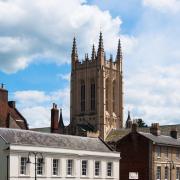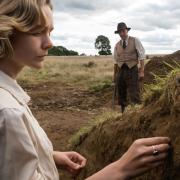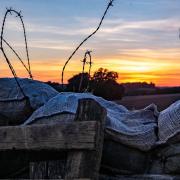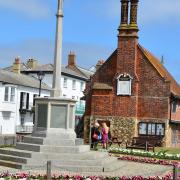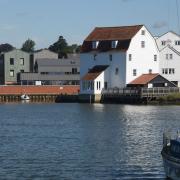The 19th century burial of a two-year-old boy at this Suffolk church was so controversial it led to fisticuffs in the churchyard and a libel case that made national headlines

The garden of Claydon Rectory, photographed by Peter Cutts, recalls the story of its 19th century creator, Reverend George Drury who was at the heart of the celebrated Akenham Burial Case.
This concerned the funeral of Joseph Ramsey, aged two, which took place at Akenham on August 23, 1878 – although the parish register only records two burials in 1878, neither of them little Joseph’s.
Akenham in the 1870s was a small, peaceful Suffolk parish. But that peace in the parish was shattered following the appointment of Rev Drury as rector of Claydon and Akenham in 1846. He brought with him High Church trappings – candles, a cross on the altar at Claydon, vestments, daily communion and incense – which irked local Protestant parishioners and the Bishop of Norwich was forced to intervene.
He also established two religious communities – a Benedictine community for men led by his friend Joseph Leycester Lyne, known as Father Ignatius, at Claydon Rectory in 1863, who preached Hell-fire and extreme Catholic teachings and drew riots, protests and violence. Again, the Bishop of Norwich had to step in.

He then founded a convent of Benedictine nuns in Claydon in 1866 which survived until 1882, leading to accusations of keeping a harem. A mob broke into the convent and ‘rescued’ one of the nuns. Rev Drury, meanwhile, built a 9ft wall around the rectory.
Things came to an explosive head when parishioners elected a local landowner and a nonconformist as churchwarden, Mr Smith of Rise Hall. Rev Drury refused to recognise a non member of the Church of England congregation as warden or to hand over the keys of the church.
Read: the Suffolk ferryman who helped Britain win the war

Joseph Ramsey’s funeral in August 1878 was the last straw. He was the son of Edward Ramsey, a Baptist employee of Mr Gooding (a nonconformist) of Akenham Hall. As an infant he had not been baptised as Baptists advocated adult baptism. But the only difference this should have made to a Church of England minister was that Rev Drury would not read the burial service from the Book of Common Prayer over the coffin. He would, however, have been expected to accompany the coffin to the burial site and to be present at the interment.
What exactly happened at the burial of Joseph Ramsey is not entirely clear, but the evidence is that the coffin arrived accompanied by Rev Wickham Tozer, a Congregational minster from Ipswich, Mr Smith, and Mr Gooding (well-to-do nonconformists) and about 20-30 mourners. Arriving at the churchyard, Rev Tozer attempted to hold a service at the edge of the field owned by Mr Smith of Rise Hall, across the track from the churchyard gate.
Rev Drury approached the group to take charge of the coffin and accompany it to the grave, but the mourners claimed that he attempted to break up the service. Rev Tozer waved a fist in the face of Rev Drury and the parents of Joseph Ramsey implored Rev Tozer to ignore Rev Drury and continue with the service. Rev Drury locked the churchyard gate and stormed off. . . without burying the child.
Locked out of the churchyard, the assembled mourners passed the coffin through the hedge and buried it without any form of service in the churchyard. With no Baptist chapel in Akenham or Claydon and no Baptist minister there was no chance of Joseph Ramsey having a Baptist burial service in a chapel prior to burial in the churchyard. But it was quite common at the time for a nonconformist service to be held in the home of a member of the church, so holding a service in the open air opposite the churchyard was unusual and contentious.
Looking back on events, it appears the nonconformists who gathered there on the August 23, 1878, set out to catch Rev Drury. And the villagers knew this High Church, dogmatic man would rise to the bait.
The following Monday a detailed account of the incident appeared in the East Anglian Daily Times headed “Burial Scandal at Akenham”. The report accused Drury of trying to prevent a Christian burial and of stating that Joseph was not a Christian and of storming off when Rev Wickham Tozer refused to shorten his service. The article concluded with the comment: “We leave the facts to tell their own tale, reminding our readers that this staunch upholder of ecclesiastical law is already under admonition from his own Bishop for lawless proceedings in his own church.”
The EADT was bombarded with letters about the funeral, commenting on Rev Drury’s ‘style’ of High Church, along with hints and innuendos about the convent. His whole character came into question with stories about him being fined for assaulting someone with a red-hot poker.
It emerged in due course that the original report had been written by none other than the Rev Wickham Tozer and some of the letters attacking Rev Drury came from people directly involved with the funeral. Rev Drury did not take this assault on his character lying down and successfully sued Frederick Wilson, the editor and owner of the EADT, for libel. Friends and supporters rallied round and Rev Drury is reported as returning to his parish a hero.
The High Court trial unearthed some odd facts about the day of the burial – Rev Wickham Tozer had never met the Ramseys before the day of Joseph’s burial and was asked by Mr Smith and Mr Gooding to conduct the impromptu service. Both men were related to the editor of Christian World magazine which picked up the Akenham story and widely promoted it. They also asked Rev Tozer to compile the written account of the proceedings, and had been given the right of correcting the final draft which found its way to the EADT.
Rev Drury might have won the High Court case, but a national fund was set up to pay Frederick Wilson’s costs of £1,000. The sum was exceeded and some of the money went towards a headstone for Joseph Ramsey.
This strange incident had a far reaching impact since it’s considered that it led directly to the passing of the Burial Laws Amendment Act of 1880 which gave free access to chaurchyards. Rev Drury remained at Claydon and Akenham until his death in 1895. He served the parishes for 39 years. . . a is buried at Claydon.





